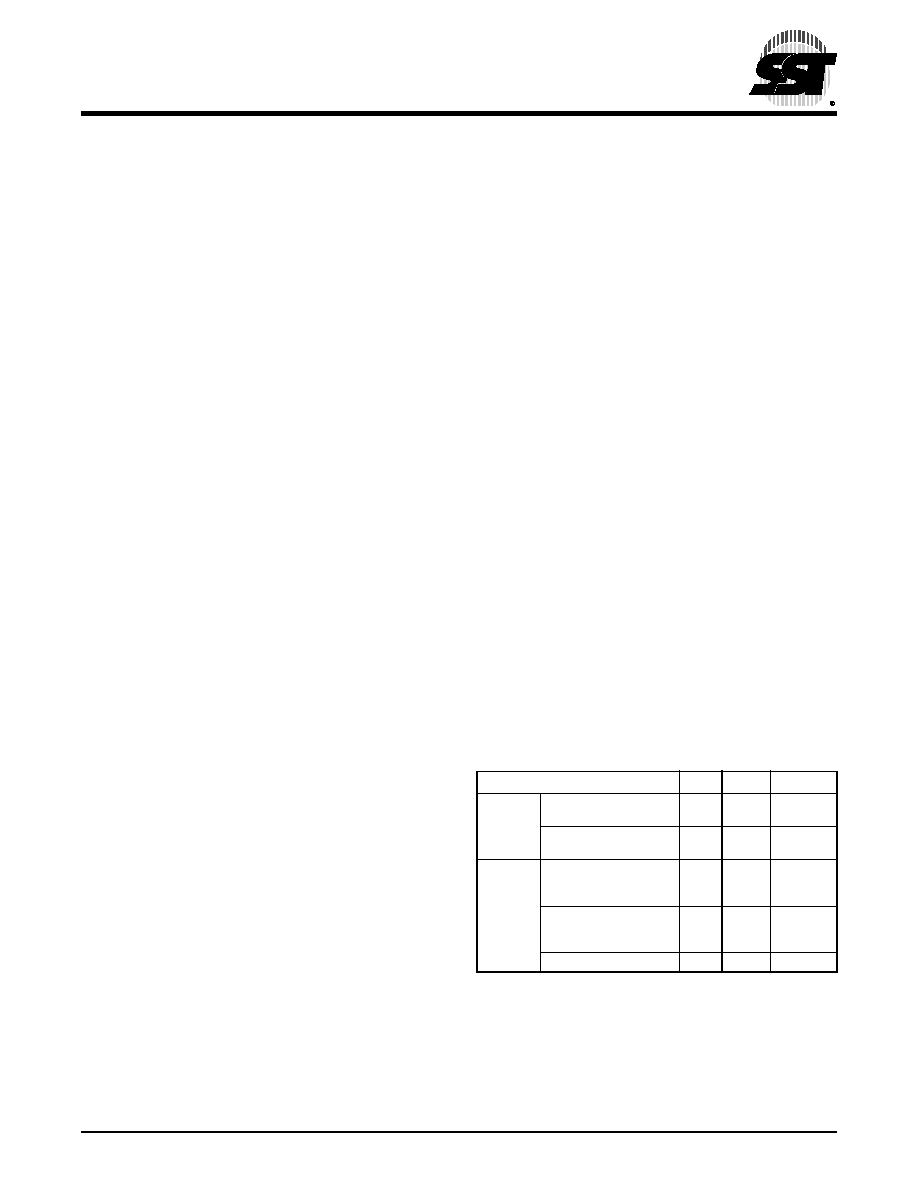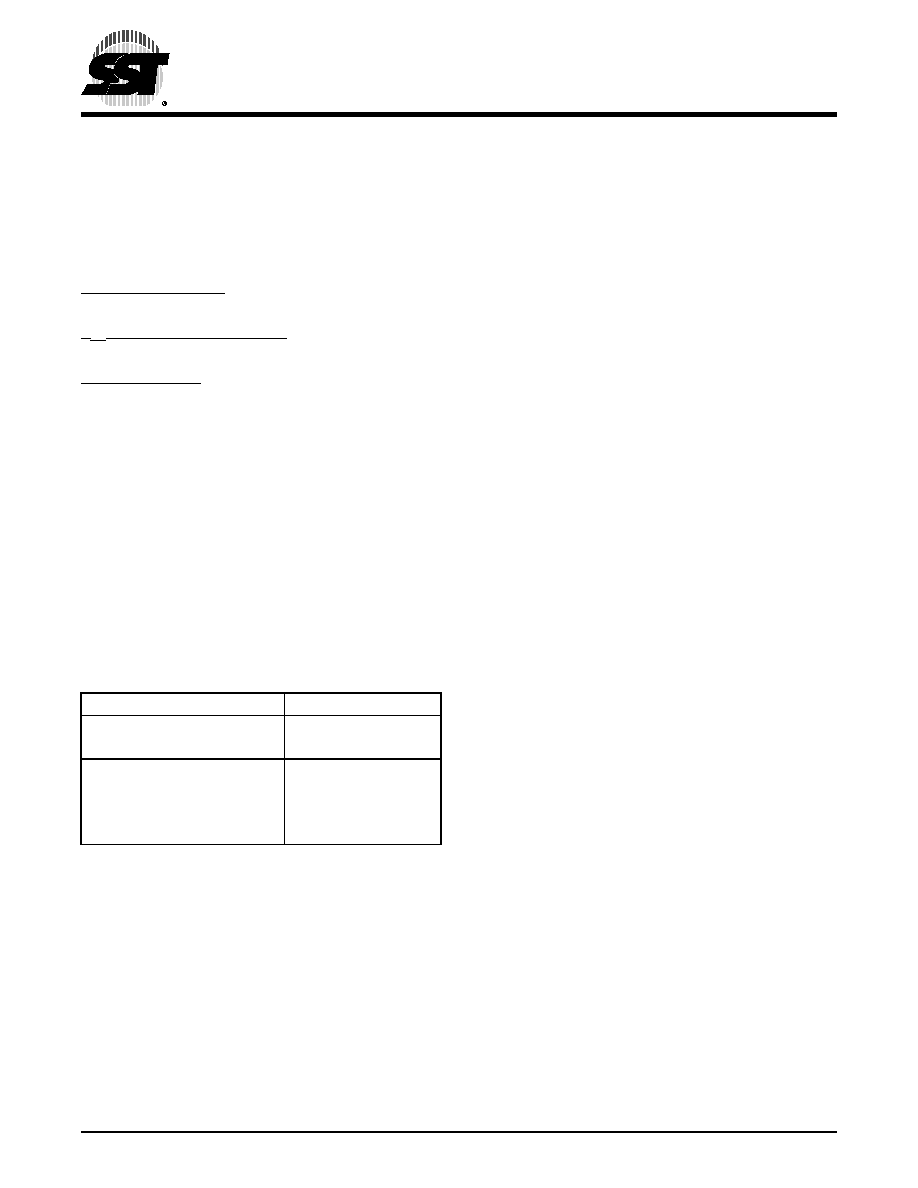
Preliminary Specifications
©2003 Silicon Storage Technology, Inc.
S71223-03-000
11/03
1
The SST logo and SuperFlash are registered trademarks of Silicon Storage Technology, Inc.
MPF is a trademark of Silicon Storage Technology, Inc.
These specifications are subject to change without notice.
16 Mbit / 32 Mbit / 64 Mbit (x16) Multi-Purpose Flash Plus
SST39VF1601 / SST39VF3201 / SST39VF6401
SST39VF1602 / SST39VF3202 / SST39VF6402
FEATURES:
∑
Organized as 1M x16: SST39VF1601/1602
2M x16: SST39VF3201/3202
4M x16: SST39VF6401/6402
∑
Single Voltage Read and Write Operations
≠ 2.7-3.6V
∑
Superior Reliability
≠ Endurance: 100,000 Cycles (Typical)
≠ Greater than 100 years Data Retention
∑
Low Power Consumption (typical values at 5 MHz)
≠ Active Current: 9 mA (typical)
≠ Standby Current: 3 µA (typical)
≠ Auto Low Power Mode: 3 µA (typical)
∑
Hardware Block-Protection/WP# Input Pin
≠ Top Block-Protection (top 32 KWord)
for SST39VF1602/3202/6402
≠ Bottom Block-Protection (bottom 32 KWord)
for SST39VF1601/3201/6401
∑
Sector-Erase Capability
≠ Uniform 2 KWord sectors
∑
Block-Erase Capability
≠ Uniform 32 KWord blocks
∑
Chip-Erase Capability
∑
Erase-Suspend/Erase-Resume Capabilities
∑
Hardware Reset Pin (RST#)
∑
Security-ID Feature
≠ SST: 128 bits; User: 128 bits
∑
Fast Read Access Time:
≠ 70 ns
≠ 90 ns
∑
Latched Address and Data
∑
Fast Erase and Word-Program:
≠ Sector-Erase Time: 18 ms (typical)
≠ Block-Erase Time: 18 ms (typical)
≠ Chip-Erase Time: 40 ms (typical)
≠ Word-Program Time: 7 µs (typical)
∑
Automatic Write Timing
≠ Internal V
PP
Generation
∑
End-of-Write Detection
≠ Toggle Bits
≠ Data# Polling
∑
CMOS I/O Compatibility
∑
JEDEC Standard
≠ Flash EEPROM Pinouts and command sets
∑
Packages Available
≠ 48-lead TSOP (12mm x 20mm)
≠ 48-ball TFBGA (6mm x 8mm) for 16M and 32M
≠ 48-ball TFBGA (8mm x 10mm) for 64M
PRODUCT DESCRIPTION
The SST39VF160x/320x/640x devices are 1M x16, 2M
x16, and 4M x16 respectively, CMOS Multi-Purpose
Flash Plus (MPF+) manufactured with SST's proprietary,
high performance CMOS SuperFlash technology. The
split-gate cell design and thick-oxide tunneling injector
attain better reliability and manufacturability compared
with alternate approaches. The SST39VF160x/320x/640x
write (Program or Erase) with a 2.7-3.6V power supply.
These devices conform to JEDEC standard pinouts for
x16 memories.
Featuring high performance Word-Program, the
SST39VF160x/320x/640x devices provide a typical Word-
Program time of 7 µsec. These devices use Toggle Bit or
Data# Polling to indicate the completion of Program opera-
tion. To protect against inadvertent write, they have on-chip
hardware and Software Data Protection schemes.
Designed, manufactured, and tested for a wide spectrum of
applications, these devices are offered with a guaranteed
typical endurance of 100,000 cycles. Data retention is rated
at greater than 100 years.
The SST39VF160x/320x/640x devices are suited for appli-
cations that require convenient and economical updating of
program, configuration, or data memory. For all system
applications, they significantly improve performance and
reliability, while lowering power consumption. They inher-
ently use less energy during Erase and Program than alter-
native flash technologies. The total energy consumed is a
function of the applied voltage, current, and time of applica-
tion. Since for any given voltage range, the SuperFlash
technology uses less current to program and has a shorter
erase time, the total energy consumed during any Erase or
Program operation is less than alternative flash technolo-
gies. These devices also improve flexibility while lowering
the cost for program, data, and configuration storage appli-
cations.
The SuperFlash technology provides fixed Erase and Pro-
gram times, independent of the number of Erase/Program
cycles that have occurred. Therefore the system software
or hardware does not have to be modified or de-rated as is
necessary with alternative flash technologies, whose
Erase and Program times increase with accumulated
Erase/Program cycles.
SST39VF160x / 320x / 640x2.7V 16Mb / 32Mb / 64Mb (x16) MPF+ memories

2
Preliminary Specifications
16 Mbit / 32 Mbit / 64 Mbit Multi-Purpose Flash Plus
SST39VF1601 / SST39VF3201 / SST39VF6401
SST39VF1602 / SST39VF3202 / SST39VF6402
©2003 Silicon Storage Technology, Inc.
S71223-03-000
11/03
To meet high density, surface mount requirements, the
SST39VF160x/320x/640x are offered in 48-lead TSOP
and 48-ball TFBGA packages. See Figures 1 and 2 for
pin assignments.
Device Operation
Commands are used to initiate the memory operation func-
tions of the device. Commands are written to the device
using standard microprocessor write sequences. A com-
mand is written by asserting WE# low while keeping CE#
low. The address bus is latched on the falling edge of WE#
or CE#, whichever occurs last. The data bus is latched on
the rising edge of WE# or CE#, whichever occurs first.
The SST39VF160x/320x/640x also have the Auto Low
Power mode which puts the device in a near standby
mode after data has been accessed with a valid Read
operation. This reduces the I
DD
active read current from
typically 9 mA to typically 3 µA. The Auto Low Power mode
reduces the typical I
DD
active read current to the range of 2
mA/MHz of Read cycle time. The device exits the Auto Low
Power mode with any address transition or control signal
transition used to initiate another Read cycle, with no
access time penalty. Note that the device does not enter
Auto-Low Power mode after power-up with CE# held
steadily low, until the first address transition or CE# is
driven high.
Read
The Read operation of the SST39VF160x/320x/640x is
controlled by CE# and OE#, both have to be low for the
system to obtain data from the outputs. CE# is used for
device selection. When CE# is high, the chip is dese-
lected and only standby power is consumed. OE# is the
output control and is used to gate data from the output
pins. The data bus is in high impedance state when
either CE# or OE# is high. Refer to the Read cycle timing
diagram for further details (Figure 3).
Word-Program Operation
The SST39VF160x/320x/640x are programmed on a
word-by-word basis. Before programming, the sector
where the word exists must be fully erased. The Program
operation is accomplished in three steps. The first step is
the three-byte load sequence for Software Data Protection.
The second step is to load word address and word data.
During the Word-Program operation, the addresses are
latched on the falling edge of either CE# or WE#, which-
ever occurs last. The data is latched on the rising edge of
either CE# or WE#, whichever occurs first. The third step is
the internal Program operation which is initiated after the
rising edge of the fourth WE# or CE#, whichever occurs
first. The Program operation, once initiated, will be com-
pleted within 10 µs. See Figures 4 and 5 for WE# and CE#
controlled Program operation timing diagrams and Figure
19 for flowcharts. During the Program operation, the only
valid reads are Data# Polling and Toggle Bit. During the
internal Program operation, the host is free to perform addi-
tional tasks. Any commands issued during the internal Pro-
gram operation are ignored. During the command
sequence, WP# should be statically held high or low.
Sector/Block-Erase Operation
The Sector- (or Block-) Erase operation allows the system
to erase the device on a sector-by-sector (or block-by-
block) basis. The SST39VF160x/320x/640x offer both Sec-
tor-Erase and Block-Erase mode. The sector architecture
is based on uniform sector size of 2 KWord. The Block-
Erase mode is based on uniform block size of 32 KWord.
The Sector-Erase operation is initiated by executing a six-
byte command sequence with Sector-Erase command
(30H) and sector address (SA) in the last bus cycle. The
Block-Erase operation is initiated by executing a six-byte
command sequence with Block-Erase command (50H)
and block address (BA) in the last bus cycle. The sector or
block address is latched on the falling edge of the sixth
WE# pulse, while the command (30H or 50H) is latched on
the rising edge of the sixth WE# pulse. The internal Erase
operation begins after the sixth WE# pulse. The End-of-
Erase operation can be determined using either Data#
Polling or Toggle Bit methods. See Figures 9 and 10 for tim-
ing waveforms and Figure 23 for the flowchart. Any com-
mands issued during the Sector- or Block-Erase operation
are ignored. When WP# is low, any attempt to Sector-
(Block-) Erase the protected block will be ignored. During
the command sequence, WP# should be statically held
high or low.
Erase-Suspend/Erase-Resume Commands
The Erase-Suspend operation temporarily suspends a
Sector- or Block-Erase operation thus allowing data to be
read from any memory location, or program data into any
sector/block that is not suspended for an Erase operation.
The operation is executed by issuing one byte command
sequence with Erase-Suspend command (B0H). The
device automatically enters read mode typically within 20
µs after the Erase-Suspend command had been issued.
Valid data can be read from any sector or block that is not
suspended from an Erase operation. Reading at address
location within erase-suspended sectors/blocks will output
DQ
2
toggling and DQ
6
at "1". While in Erase-Suspend
mode, a Word-Program operation is allowed except for the
sector or block selected for Erase-Suspend.

Preliminary Specifications
16 Mbit / 32 Mbit / 64 Mbit Multi-Purpose Flash Plus
SST39VF1601 / SST39VF3201 / SST39VF6401
SST39VF1602 / SST39VF3202 / SST39VF6402
3
©2003 Silicon Storage Technology, Inc.
S71223-03-000
11/03
To resume Sector-Erase or Block-Erase operation which has
been suspended the system must issue Erase Resume
command. The operation is executed by issuing one byte
command sequence with Erase Resume command (30H)
at any address in the last Byte sequence.
Chip-Erase Operation
The SST39VF160x/320x/640x provide a Chip-Erase oper-
ation, which allows the user to erase the entire memory
array to the "1" state. This is useful when the entire device
must be quickly erased.
The Chip-Erase operation is initiated by executing a six-
byte command sequence with Chip-Erase command
(10H) at address 5555H in the last byte sequence. The
Erase operation begins with the rising edge of the sixth
WE# or CE#, whichever occurs first. During the Erase
operation, the only valid read is Toggle Bit or Data# Polling.
See Table 6 for the command sequence, Figure 9 for tim-
ing diagram, and Figure 23 for the flowchart. Any com-
mands issued during the Chip-Erase operation are
ignored. When WP# is low, any attempt to Chip-Erase will
be ignored. During the command sequence, WP# should
be statically held high or low.
Write Operation Status Detection
The SST39VF160x/320x/640x provide two software
means to detect the completion of a Write (Program or
Erase) cycle, in order to optimize the system write cycle
time. The software detection includes two status bits: Data#
Polling (DQ
7
) and Toggle Bit (DQ
6
). The End-of-Write
detection mode is enabled after the rising edge of WE#,
which initiates the internal Program or Erase operation.
The actual completion of the nonvolatile write is asyn-
chronous with the system; therefore, either a Data# Poll-
ing or Toggle Bit read may be simultaneous with the
completion of the write cycle. If this occurs, the system
may possibly get an erroneous result, i.e., valid data may
appear to conflict with either DQ
7
or DQ
6
. In order to pre-
vent spurious rejection, if an erroneous result occurs, the
software routine should include a loop to read the
accessed location an additional two (2) times. If both
reads are valid, then the device has completed the Write
cycle, otherwise the rejection is valid.
Data# Polling (DQ
7
)
When the SST39VF160x/320x/640x are in the internal
Program operation, any attempt to read DQ
7
will produce
the complement of the true data. Once the Program oper-
ation is completed, DQ
7
will produce true data. Note that
even though DQ
7
may have valid data immediately follow-
ing the completion of an internal Write operation, the
remaining data outputs may still be invalid: valid data on the
entire data bus will appear in subsequent successive Read
cycles after an interval of 1 µs. During internal Erase oper-
ation, any attempt to read DQ
7
will produce a `0'. Once the
internal Erase operation is completed, DQ
7
will produce a
`1'. The Data# Polling is valid after the rising edge of fourth
WE# (or CE#) pulse for Program operation. For Sector-,
Block- or Chip-Erase, the Data# Polling is valid after the
rising edge of sixth WE# (or CE#) pulse. See Figure 6 for
Data# Polling timing diagram and Figure 20 for a flowchart.
Toggle Bits (DQ6 and DQ2)
During the internal Program or Erase operation, any con-
secutive attempts to read DQ
6
will produce alternating "1"s
and "0"s, i.e., toggling between 1 and 0. When the internal
Program or Erase operation is completed, the DQ
6
bit will
stop toggling. The device is then ready for the next opera-
tion. For Sector-, Block-, or Chip-Erase, the toggle bit (DQ
6
)
is valid after the rising edge of sixth WE# (or CE#) pulse.
DQ
6
will be set to "1" if a Read operation is attempted on an
Erase-Suspended Sector/Block. If Program operation is ini-
tiated in a sector/block not selected in Erase-Suspend
mode, DQ
6
will toggle.
An additional Toggle Bit is available on DQ
2
, which can be
used in conjunction with DQ
6
to check whether a particular
sector is being actively erased or erase-suspended. Table 1
shows detailed status bits information. The Toggle Bit
(DQ
2
) is valid after the rising edge of the last WE# (or CE#)
pulse of Write operation. See Figure 7 for Toggle Bit timing
diagram and Figure 20 for a flowchart.
Note: DQ
7
and DQ
2
require a valid address when reading
status information.
TABLE
1: W
RITE
O
PERATION
S
TATUS
Status
DQ
7
DQ
6
DQ
2
Normal
Operation
Standard
Program
DQ
7
#
Toggle
No Toggle
Standard
Erase
0
Toggle
Toggle
Erase-
Suspend
Mode
Read from
Erase-Suspended
Sector/Block
1
1
Toggle
Read from
Non- Erase-Suspended
Sector/Block
Data
Data
Data
Program
DQ
7
#
Toggle
N/A
T1.0 1223

4
Preliminary Specifications
16 Mbit / 32 Mbit / 64 Mbit Multi-Purpose Flash Plus
SST39VF1601 / SST39VF3201 / SST39VF6401
SST39VF1602 / SST39VF3202 / SST39VF6402
©2003 Silicon Storage Technology, Inc.
S71223-03-000
11/03
Data Protection
The SST39VF160x/320x/640x provide both hardware and
software features to protect nonvolatile data from inadvertent
writes.
Hardware Data Protection
Noise/Glitch Protection: A WE# or CE# pulse of less than 5
ns will not initiate a write cycle.
V
DD
Power Up/Down Detection: The Write operation is
inhibited when V
DD
is less than 1.5V.
Write Inhibit Mode: Forcing OE# low, CE# high, or WE#
high will inhibit the Write operation. This prevents inadvert-
ent writes during power-up or power-down.
Hardware Block Protection
The SST39VF1602/3202/6402 support top hardware block
protection, which protects the top 32 KWord block of the
device. The SST39VF1601/3201/6401 support bottom
hardware block protection, which protects the bottom 32
KWord block of the device. The Boot Block address ranges
are described in Table 2. Program and Erase operations
are prevented on the 32 KWord when WP# is low. If WP# is
left floating, it is internally held high via a pull-up resistor,
and the Boot Block is unprotected, enabling Program and
Erase operations on that block.
Hardware Reset (RST#)
The RST# pin provides a hardware method of resetting the
device to read array data. When the RST# pin is held low
for at least T
RP,
any in-progress operation will terminate and
return to Read mode. When no internal Program/Erase
operation is in progress, a minimum period of T
RHR
is
required after RST# is driven high before a valid Read can
take place (see Figure 15).
The Erase or Program operation that has been interrupted
needs to be reinitiated after the device resumes normal
operation mode to ensure data integrity.
Software Data Protection (SDP)
The SST39VF160x/320x/640x provide the JEDEC
approved Software Data Protection scheme for all data
alteration operations, i.e., Program and Erase. Any Pro-
gram operation requires the inclusion of the three-byte
sequence. The three-byte load sequence is used to initiate
the Program operation, providing optimal protection from
inadvertent Write operations, e.g., during the system
power-up or power-down. Any Erase operation requires the
inclusion of six-byte sequence. These devices are shipped
with the Software Data Protection permanently enabled.
See Table 6 for the specific software command codes. Dur-
ing SDP command sequence, invalid commands will abort
the device to read mode within T
RC.
The contents of DQ
15
-
DQ
8
can be V
IL
or V
IH
, but no other value, during any SDP
command sequence.
Common Flash Memory Interface (CFI)
The SST39VF160x/320x/640x also contain the CFI infor-
mation to describe the characteristics of the device. In
order to enter the CFI Query mode, the system must write
three-byte sequence, same as product ID entry command
with 98H (CFI Query command) to address 5555H in the
last byte sequence. Once the device enters the CFI Query
mode, the system can read CFI data at the addresses
given in Tables 7 through 10. The system must write the
CFI Exit command to return to Read mode from the CFI
Query mode.
TABLE
2: B
OOT
B
LOCK
A
DDRESS
R
ANGES
Product
Address Range
Bottom Boot Block
SST39VF1601/3201/6401
000000H-007FFFH
Top Boot Block
SST39VF1602
0F8000H-0FFFFFH
SST39VF3202
1F8000H-1FFFFFH
SST39VF6402
3F8000H-3FFFFFH
T2.0 1223

Preliminary Specifications
16 Mbit / 32 Mbit / 64 Mbit Multi-Purpose Flash Plus
SST39VF1601 / SST39VF3201 / SST39VF6401
SST39VF1602 / SST39VF3202 / SST39VF6402
5
©2003 Silicon Storage Technology, Inc.
S71223-03-000
11/03
Product Identification
The Product Identification mode identifies the devices as
the SST39VF1601, SST39VF1602, SST39VF3201,
SST39VF3202, SST39VF6401, SST39VF6402, and
manufacturer as SST. This mode may be accessed soft-
ware operations. Users may use the Software Product
Identification operation to identify the part (i.e., using the
device ID) when using multiple manufacturers in the same
socket. For details, see Table 6 for software operation,
Figure 11 for the Software ID Entry and Read timing dia-
gram and Figure 21 for the Software ID Entry command
sequence flowchart.
Product Identification Mode Exit/
CFI Mode Exit
In order to return to the standard Read mode, the Software
Product Identification mode must be exited. Exit is accom-
plished by issuing the Software ID Exit command
sequence, which returns the device to the Read mode.
This command may also be used to reset the device to the
Read mode after any inadvertent transient condition that
apparently causes the device to behave abnormally, e.g.,
not read correctly. Please note that the Software ID Exit/
CFI Exit command is ignored during an internal Program or
Erase operation. See Table 6 for software command
codes, Figure 13 for timing waveform, and Figures 21 and
22 for flowcharts.
Security ID
The SST39VF160x/320x/640x devices offer a 256-bit
Security ID space. The Secure ID space is divided into two
128-bit segments - one factory programmed segment and
one user programmed segment. The first segment is pro-
grammed and locked at SST with a random 128-bit num-
ber. The user segment is left un-programmed for the
customer to program as desired.
To program the user segment of the Security ID, the user
must use the Security ID Word-Program command. To
detect end-of-write for the SEC ID, read the toggle bits. Do
not use Data# Polling. Once this is complete, the Sec ID
should be locked using the User Sec ID Program Lock-Out.
This disables any future corruption of this space. Note that
regardless of whether or not the Sec ID is locked, neither
Sec ID segment can be erased.
The Secure ID space can be queried by executing a three-
byte command sequence with Enter Sec ID command
(88H) at address 5555H in the last byte sequence. To exit
this mode, the Exit Sec ID command should be executed.
Refer to Table 6 for more details.
TABLE
3: P
RODUCT
I
DENTIFICATION
Address
Data
Manufacturer's ID
0000H
BFH
Device ID
SST39VF1601
0001H
234BH
SST39VF1602
0001H
234AH
SST39VF3201
0001H
235BH
SST39VF3202
0001H
235AH
SST39VF6401
0001H
236BH
SST39VF6402
0001H
236AH
T3.2 1223




